Gummy stem blight of greenhouse cucumber
Learn symptoms, disease cycle and management strategies for gummy stem blight in greenhouse cucumbers.
ISSN 1198-712X, Published October 2009
Introduction
Gummy stem blight is a common disease found worldwide in greenhouse cucumber. It is caused by the fungus Didymella bryoniae, previously named Mycosphaerella melonis and M. citrullina. In Europe, this disease is also called mycosphaerella rot. This pathogen infects only members of the cucurbit family such as cucumber, squash, melon, pumpkin, vegetable marrows, bitter melon and zucchini. The fungus attacks all parts of the plant, and under favourable conditions, causes severe economic losses.
Symptoms
Stems
Early symptoms consist of pale brown lesions at wounds created by removing leaves, fruits and lateral shoots. These lesions become dotted and almost entirely covered with tiny black spore-producing fruiting bodies. They may also crack and exude a gummy amber-coloured sap (Figure 1). Such lesions often occur at the base of the main stem, and if girdling by the lesions is complete, wilting and plant death will result. If seeds are contaminated with this pathogen, damping-off will occur.
Fruits
Fruits can be affected internally and externally. Internal fruit rot is not externally visible and is characterized by a tapering of the blossom end (Figure 2) and discoloured centrally located tissues (Figure 3). The brownish-black internal discoloration often extends for 1-2 cm along the length of the fruit. If the disease is more severe, the blossom end tapers even more directly to a point and becomes black due to the profusion of fruiting bodies externally (Figure 4). External fruit lesions appear as irregular circular spots that are initially yellow, then grey to brown. These lesions are soft, wet, sunken, and often contain spots of gummy exudate at the centre. Symptoms become visible mostly during storage.
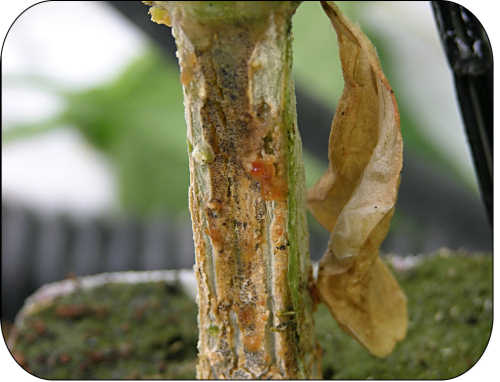
Figure 1. Stem cracks, amber-coloured gummy droplets and tiny black spore-producing bodies at base of cucumber stem.
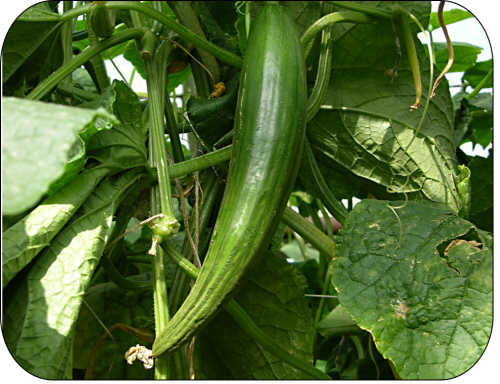
Figure 2. Narrowing of blossom end of fruit due to gummy stem blight infection.
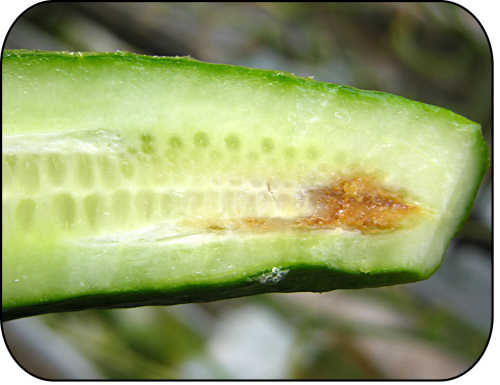
Figure 3. Internal discolouration and rotting of fruit due to gummy stem blight.
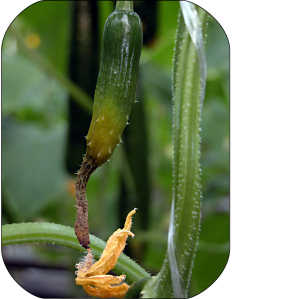
Figure 4. Advanced external symptoms of gummy stem blight.
Leaves
Leaf symptoms are usually visible at the tips (Figure 5) as pale yellow or brown dead tissue, often with a yellow halo, extending backwards in a V-shape (Figure 6). Sometimes the entire margin is affected, creating a brown edge and a downward cupping of the leaf. Lesions may also consist of circular spots on the leaves.
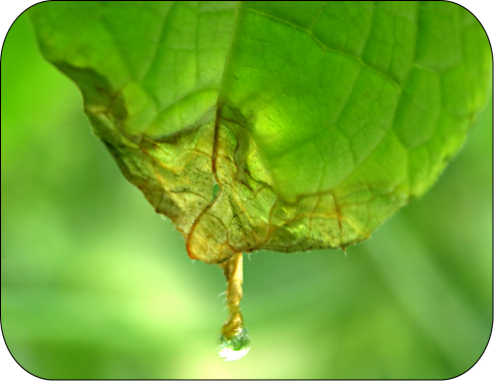
Figure 5. Early symptoms of gummy stem blight infection on leaf beginning at leaf tip.
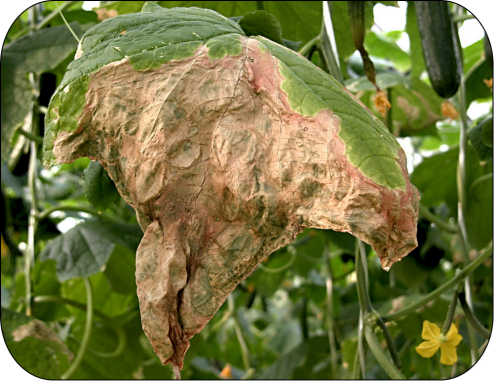
Figure 6. Advanced V-shaped symptoms of gummy stem blight infection on mature leaf.
Disease Cycle
Didymella bryoniae is highly resistant to dry conditions and it can survive as dormant mycelia or hardy structures called chlamydospores in undecomposed debris for up to two years. The fungus essentially produces two types of spores: conidia that may be dispersed by splashing water, and ascospores that are spread by air current. Both types of spores are also spread on fingers, knives, wet hands and clothing.
Gummy stem blight develops in humid conditions and in free moisture on leaf surfaces. The most significant contributor to establishing the infection is how long plant surfaces remain wet. One hour of free water on leaves is sufficient for initial infection; however, continuous leaf wetness is required for subsequent expansion of lesions. Germination and spore production, development of symptoms on stems, and infection of cucumber leaves, petioles and flowers can occur over a wide range of temperatures (5°C to 35°C), but optimum temperatures are 24°C to 25°C.
Wounding
Wounding is another factor that facilitates infection, particularly in older plant parts. In young plant tissue, however, wounding is not necessary for infection to occur. Wounding may result from damage due to crop activities (e.g. deleafing, fruit harvest) or guttation (exudation of plant sap from the ends of leaf veins and its evaporation, which can cause a localized buildup of salts) (Figure 7). Guttation is often seen in very humid greenhouses in the early morning.
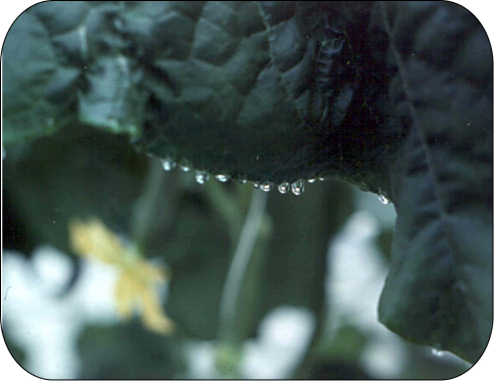
Figure 7. Guttation or exudation of droplets from ends of leaf veins.
Internal fruit rot
Internal fruit rot is usually introduced through the flower end, but occasionally from the stem. For flower infections, the fungus grows through the stigma and style into the fruit where it causes rotting and discoloration of the central tissue. The fungus requires two days to travel from the fresh flower into the fruit. Infection of fresh flowers results in more fruit infection than does infection of wilted flowers. When spore concentrations are high, there are more fruit abortions; when spore concentration is low, there is more internal fruit rot. Humid conditions also favour internal fruit rot because such conditions enhance release of ascospores which increase chances of flower infection and accompanying internal fruit rot.
Factors such as fruit thinning and duration of fruit growth do not significantly affect fruit infection. However, water shortage before and after flowering increase internal fruit rot. Removing flowers from the fruit reduces infection but is time-consuming. Thus, a cultivar in which the flowers fall off early in fruit development would be advantageous. In addition, rapidly developing fruit are more capable of limiting the fruit rot process, compared to slowly developing fruit (i.e. less than 10 cm growth in 14 days).
External fruit rot
Wounding is the most important factor in external fruit rot. This type of rot originates from infection through surface wounds, and is caused by fungal growth into the fruit tissue. Generally, wounding of the fruit, however slight, improper storage immediately after harvest, and excessive nitrogen fertilization increases the fruits susceptibility to external fruit rot.
Management
The disease can be managed by a combination of cultural, biological, and chemical strategies.
Cultural Practices
Sanitation
- Implement good sanitation measures to reduce sources of the fungus.
- During and after crop production, remove all plant debris from the greenhouse area, and bury or compost it. Didymella bryoniae persists longer in debris left on the soil surface compared to those that are buried. This pathogen can survive for at least 10 months in cucumber stems buried in dry, nonsterile soil in a greenhouse, and for 18 months in dried, infected cucumber stems left on the soil surface. Such undecomposed crop residue becomes a source of airborne spores when it is wetted. Ascospores can be released 3 hours after wetting of infected plant material.
- In between crops, remove all plant debris, including plant tendrils on the wire, prior to washing and disinfecting the greenhouse interior and superstructures.
Environment Manipulation
- Prevent or minimize periods of leaf wetness.
- Maintain a low relative humidity or moderate vapour pressure deficit (VPD) to decrease water condensation on fruit and leaves.
- Transition from night to day temperature before sunrise to prevent dew-formation on the relatively cool plants. Raise the night temperature to day levels about 3 hr before sunrise, providing sufficient time for plants to warm up prior to sunrise. This technique is especially helpful in reducing internal fruit rot. The later this transition occurs, the longer the periods of high air humidity, and correspondingly, the higher the incidence of stem infections and internal fruit rot.
- Maintain adequate ventilation in the greenhouse at all times to minimize the presence of free water on the plant surfaces. The greater the difference between heating and ventilation temperature, the greater the risk of incidence of gummy stem blight. For example, a ventilation temperature of 26°C can increase internal fruit rot by two to three times, compared to 23°C.
Harvesting Technique
- Always cut fruit flush with the stem surface. Pulling damages both the stem and the fruit, giving easy access to the fungus.
- In a heavily infested crop, disinfect pruning knives frequently.
Plant Nutrition
- Nutrient solutions with higher electrical conductivities (ECs) and adequate calcium levels strengthen the outer fruit tissues, reducing internal and external fruit rot.
- The effect of solution ECs is less marked on symptom development on the stem.
Crop Maintenance
- Excessive vegetative growth encourages gummy stem blight because of poor air-circulation within the crop.
- Prune crops regularly. In particular, remove wilted leaves and shoots which, if left on the plant, can provide nutrients to the fungus, leading to increased spore production and more infections.
Greenhouse Cover
- Ultraviolet (UV)-absorbing plastic films may help reduce the incidence of gummy stem blight. UV light is required for spore production by several fungal pathogens including D. bryoniae. Research indicates that the upper limit of wavelength for production of spore-producing bodies of D. bryoniae is 365-375 nm. One study shows that disease lesions and incidence of spore-producing bodies in watermelons grown under UV-absorbing film were reduced by 90 per cent and 80 per cent, respectively.
Alternate Hosts
- Avoid planting cucurbit crops near the greenhouse because these may serve as hosts for the fungus.
Storage Conditions
- Store fruit immediately after harvest in a cold room at 10°C-12°C with rapid forced air cooling. An 8-hour storage period at 20°C followed by storage at 11°C stimulates the rotting process.
- Do not store cucumbers with other produce that release ethylene gas, such as tomatoes and apples as ethylene accelerates ripening and fruit rotting.
- Avoid injury to the fruit during picking, packing and shipping.
Biological & Chemical
Microbial and conventional fungicides registered for management of gummy stem blight are listed in OMAFRA Publication 836, Growing Greenhouse Vegetables in Ontario.
This Factsheet was authored by G. Ferguson, Greenhouse Vegetable IPM Specialist, OMAFRA, Harrow; R. Cerkauska, Agriculture and Agri-Food Canada, Harrow; and S. Khosla, Greenhouse Vegetable Specialist, OMAFRA, Harrow. This Factsheet is a revision of a Factsheet originally authored by S. K. Khosla (OMAFRA, Harrow) and W.R. Jarvis and A.P. Papadopoulos (AAFC, Harrow).